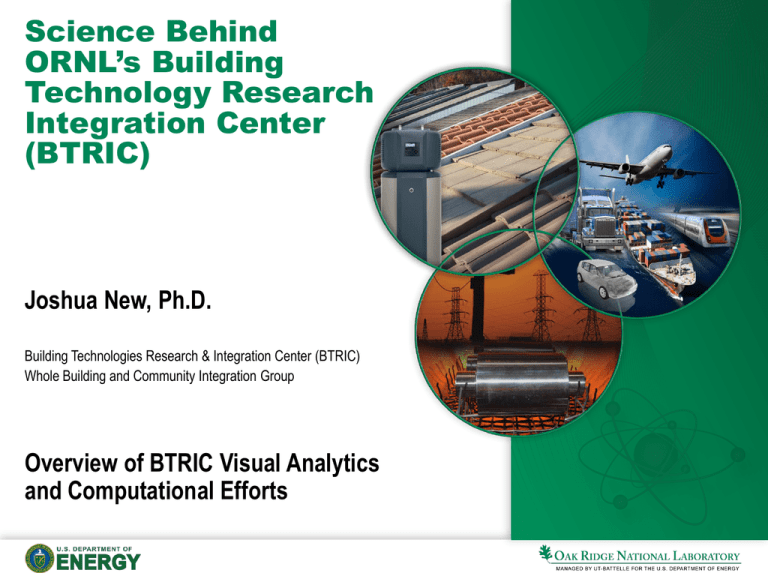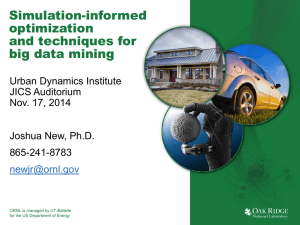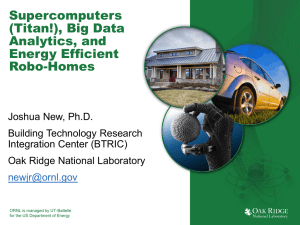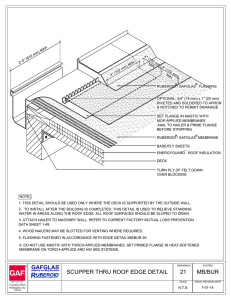Science Behind ORNL’s Building Technology Research Integration Center
advertisement

Science Behind
ORNL’s Building
Technology Research
Integration Center
(BTRIC)
Joshua New, Ph.D.
Building Technologies Research & Integration Center (BTRIC)
Whole Building and Community Integration Group
Overview of BTRIC Visual Analytics
and Computational Efforts
Presentation summary
•
Scientific Paradigms
•
Roof Savings Calculator
•
Visual Analytics
•
Machine Learning
•
Prediction of Electrical Consumption
•
Autotune
2 Green Economy 1302
Presentation summary
•
Scientific Paradigms
•
Roof Savings Calculator
•
Visual Analytics
•
Machine Learning
•
Prediction of Electrical Consumption
•
Autotune
3 Green Economy 1302
4th Paradigm –
The Science behind the Science
• Empirical – guided by experiment/observation
– In use thousands of years ago, natural phenomena
Tycho Brahe
• Theoretical – based on coherent group of principles and
theorems
– In use hundreds of years ago, generalizations
Johannes Kepler
• Computational – simulating complex phenomena
– In use for decades
• Data exploration (eScience) – unifies all 3
– Data capture, curation, storage,
analysis, and visualization
4
4th Paradigm
5
Presentation summary
•
Scientific Paradigms
•
Roof Savings Calculator
•
Visual Analytics
•
Machine Learning
•
Prediction of Electrical Consumption
•
Autotune
COMPUTER TOOL FOR SIMULATING
COOL ROOFS
Roof Savings Calculator (RSC)
Chris Scruton
CEC
INDUSTRY
Marc LaFrance
DOE BT
COLLABORATIVE R&D
R. Levinson,
H. Gilbert,
H. Akbari
A. Desjarlais,
W. Miller,
J. New
WBT
Joe Huang,
Ender Erdem
Roof Savings Calculator
Replaces:
EPA Roof Comparison Calc
DOE Cool Roof Calculator
Minimal questions (<20)
Only location is required
Building America defaults
Help links for unknown
information
8
RSC = AtticSim + DOE-2.1E
AtticSim - ASTM C 1340 Standard For Estimating Heat Gain or Loss
Through Ceilings Under Attics
Summer Operation of HVAC Duct in
ASHRAE Climate Zone 3
Roof Savings Calculator
DOE-2.1E+AtticSim
• Building Details
• HVAC efficiency and
utility prices
• Roof and Attic
Information
(base vs. comp)
• Reports energy and
cost savings
11
Commercial building types
Office
“Big Box” Retail
Warehouse
Torcellini et al. 2008, “DOE Commercial Building Benchmark Models”,
NREL/CP-550-43291, National Renewable Energy Laboratory, Golden CO.
AtticSim
DOE-2
RoofCalc.com Impact
24,100 web simulations, 156 users/feedback, 3+ million runs
Average: ~100 visitors/day
14
Enhanced RSC Site
Result Output
Input Parameter GUI
Results
User
Inputs
Savings
Exists?
Hyperion
Database
Simulate
Savings
Simulation
RSC Engine
Testing RSC – Python Robot Framework
Current Results
Description
Reflectance
Emissivity
SRI
Atlanta
Austin
Baltimore
BUR No Coating
10
90
6
-54
0
Mineral Mod Bit
25
88
25
-422
-39
Single Ply
32
90
35
-384
71
-437
Mineral Mod Bit
33
92
35
-574
3
-655
Metal
35
82
35
-883
-191
-1000
Aluminum Coating over BUR
43
58
35
-9
189
-64
-46
Mineral Mod Bit
45
79
55
-564
84
-657
-408
Coating over BUR
49
83
55
-413
231
-461
-250
Metal
49
83
55
-1191
-126
-1231
-837
Aluminum Coating over BUR
55
45
48
39
174
-35
-29
Mineral Mod Bit
63
88
75
-909
203
-996
-571
Coating over BUR
63
86
75
-606
334
-664
-347
Metal
63
84
75
-1487
-31
-1465
-919
Single Ply
64
80
75
-637
304
-712
-386
Aluminum Coating over BUR
65
45
65
-80
272
-160
-88
Metal (White)
70
85
85
-1622
14
-1592
-967
Coating over BUR (White)
75
90
93
-770
417
-875
-443
Single Ply (White)
76
87
94
-840
384
-962
Coating over BUR (White)
79
90
100
-812
450
-928
Mineral Mod Bit (White)
81
80
100
-1025
355
Single Ply (White)
82
79
100
-819
Coating over BUR (White)
85
90
107
Single Ply (White)
85
87
107
Fargo
Los
Houston Kansas City Angeles
Chicago
Fairbanks
Miami
Minneapolis
-66
-36
-125
-99
42
-47
98
75
-507
-325
-941
-659
103
-368
383
276
-253
-901
-660
230
-320
614
441
-407
-1302
-908
197
-477
648
463
-742
-2213
-1296
60
-698
293
212
-237
-298
279
-45
585
-1385
-1003
291
-475
872
-1154
-872
433
-345
1075
742
-2855
-1697
208
-857
771
576
-276
-367
390
-21
825
502
-2372
-1661
525
-726
1473
1105
-1787
-1305
607
-501
1512
1102
-3600
-2151
361
-1028
1295
986
-1850
-1345
578
-528
1480
1067
-694
-696
-655
542
-123
1230
758
-4005
-2422
436
-1133
1522
1211
-2391
-1732
767
-664
1822
1460
-502
-2547
-1829
745
-722
1808
-471
-2571
-1862
820
-710
1906
-1161
-642
-3006
-2131
748
-867
455
-949
-494
-2643
-1912
822
-873
499
-1008
-524
-2845
-2073
-936
459
-1083
-577
-2969
-2143
San
Francisco
New York
Phoenix
-53
-89
39
-68
-419
-669
70
-420
-382
-582
154
-494
-560
-871
118
-659
-863
-1558
74
-322
372
-93
-189
294
-58
594
-582
-907
216
-693
-441
-680
348
-640
-1102
-1891
138
-957
-90
-202
419
-51
-933
-1380
300
-1419
-659
-980
452
-1104
-1356
-2198
171
-1704
-1031
408
-1105
-227
-399
558
-301
-1502
-2353
166
-2131
-900
-1261
526
-1642
1460
-974
-1358
471
-1720
1576
-974
-1336
553
-1825
1876
1556
-1175
-1634
444
-2057
-722
1934
1578
-1002
-1373
554
-1847
905
-782
2003
1761
-1097
-1454
592
-2123
871
-830
1974
1736
-1156
-1536
531
-2167
RSC Web Service
• SoapResults = simulate(SoapModel)
– Accepts a model and returns the RSC results
• ZipString = test(SoapModel)
– Forces the model to be evaluated by the engine (rather than
checking the database) and returns a zip (as a base64encoded string) of the DOE2/AtticSim output files
• ScenarioID = upload(SoapModel, SoapResults)
– Uploads the model and results to the database, bypassing the
engine
• (SoapModel, SoapResults) = download(ScenarioID,
VersionNumber)
– Downloads a model/result pair for the scenario ID and version
number
RSC Service Example (Python)
client = suds.client.Client('URL/TO/WEB/SERVICE/rsc.wsdl')
print(client)
sm = client.factory.create('schema:soapmodel')
load_soap_model_from_xml('../examplemodel.xml', sm)
sr = client.service.simulate(sm)
print(sr)
sm = client.factory.create('schema:soapmodel')
load_soap_model_from_xml('../examplemodel.xml', sm)
print(sm)
contents = client.service.test(sm)
with open('pytest.zip', 'wb') as outfile:
outfile.write(base64.b64decode(contents))
sm = client.factory.create('schema:soapmodel')
load_soap_model_from_xml('../examplemodel.xml', sm)
sr = client.factory.create('schema:soapresults')
load_soap_results_from_xml('../exampleresults.xml', sr)
sid = client.service.upload(sm, sr)
print(sid)
modres = client.service.download(83356208, '0.9')
print(modres['soapmodel'])
print(modres['soapresults'])
Millions of simulations visualized for DOE’s Roof
Savings Calculator and deployment of roof and attic
technologies through leading industry partners
DOE: Office of Science
CEC & DOE EERE: BTO
Industry & Building Owners
CentiMark, the largest nation-wide
roofing contractor (installs 2500
roofs/mo), is integrating RSC into
their proposal generating system
(others expected to follow)
AtticSim
Engine (AtticSim/DOE-2) debugged
using HPC Science assets enabling
visual analytics on 3x(10)6 simulations
DOE-2
Roof Savings Calculator (RSC) web
site/service developed and validated
[estimates energy cost savings of
improvements to flat or sloped roofs for
any existing condition or climate]
Leveraging HPC resources to facilitate deployment of building energy efficiency technologies
Presentation summary
•
Scientific Paradigms
•
Roof Savings Calculator
•
Visual Analytics
•
Machine Learning
•
Prediction of Electrical Consumption
•
Autotune
Current Projects
• UC-Berkeley – testing, regression (quick estimation, rules of
thumb) [donated effort]
RSC
Simulations
Testing
Analysis
RoofCalc.com
CITRIS, UC-Berkeley
96 ~ HP rx2600
Web Server
PowerEdge R510
22
Visual Analytics (demo)
• Visualization techniques (for Energy Simulation)
– City-Scape, Artificial Terrain
23
Climate Zone Map
• Climate zones (1-8) shown on map.
High-Density Time Plots
• Each line is the energy usage for a single simulation
• High Dynamic Range rendering (HDR)
• Apply logarithmic coloring scaling to emphasis high
traffic regions
• Render outlier lines separately
Context
Focus
Category View
• Bars for each category show occupancy levels
Basement (19%)
Slab (37%)
Crawl Space (80%)
• Grouped by dimension; highlighting & focus rendering
Foundation Type
Categorical Context
Mouse Hover Highlight
Vintage
Categorical Focus
HVAC
Parallel Coordinates
• One parallel axis per data dimension;
One line per data item crosses every axis
Scatterplot
vs.
Max
Max
X
Y
Min
Parallel Coordinates
X
Max
Min
Y
PCP - car data set
PCP Bin Rendering
• Transfer Function Coloring:
– Occupancy or Leading Axis
Bug Vis Old New
11 23 3 11
Outliers (Heating)
• Selection of heating outliers
• Find all have box building
type and in Miami
Presentation summary
•
Scientific Paradigms
•
Roof Savings Calculator
•
Visual Analytics
•
Machine Learning
•
Prediction of Electrical Consumption
•
Autotune
Image Fusion
(based on cone-fusion of mammalian retina)
Typical MRI and SPECT imagery
Colorfuse Image
Learning Associations
Full Results
DetailResults
Presentation summary
•
Scientific Paradigms
•
Roof Savings Calculator
•
Visual Analytics
•
Machine Learning
•
Prediction of Electrical Consumption
•
Autotune
Source of Input Data
• 3 Campbell Creek homes
(TVA, ORNL, EPRI)
• 100+ sensors/home, 15-minute data:
•
•
•
•
•
•
Temperature (inside/outside)
Plugs
Lights
• Dryer
Range
• Refrigerator
Washer
• Dishwasher
Radiated heat
• Heat pump air flow
• Shower water flow
• Etc.
List of Machine Learning
Techniques to Explore
• Linear Regression
• Feedforward Neural
Network
• Support Vector Machine
Regression
• Non-Linear Regression
• K-Means with Local Models
• Gaussian Mixture Model
with Local Models
• Self-Organizing Map with Local
Models
• Regression Tree (using Information
Gain)
• Time Modeling with Local Models
• Recurrent Neural Networks
• Neural Network with Genetic
Algorithm
• Ensemble Learning
• Acknowledgment: UTK computer science Ph.D. student Richard
Edwards is doing bulk of the work; student of Dr. Lynne Parker
Example Results
• Robust Linear Regression Model can map current
sensor observations to energy use
House 1 (House 2 is similar)
House 3 – More difficult, due to
solar energy input
Example Results to Date (con’t.)
• Robust Linear Regression Model for predicting energy
usage 1 hour ahead:
House 2 (House 1 is similar)
(all models are Markov Order 3)
House 3
Performance Metrics
Presentation summary
•
Scientific Paradigms
•
Roof Savings Calculator
•
Visual Analytics
•
Machine Learning
•
Prediction of Electrical Consumption
•
Autotune
The Autotune Idea
Making building energy models more useful by calibrating them to data
E+ Input
Model
.
.
.
Goal: Reduce Project Development Costs for
Small Building Retrofit Projects
Handful of Data Channels & Weather
• High performance computing applied to task of auto-tuning building
energy models
– Jaguar, Nautilus & Frost supercomputers all engaged (32k E+ sims in <5 mins!)
– ORNL, U of Tennessee-Knoxville, Jacksonville State U
Computational Complexity
Problems/Opportunities:
Thousands of parameters per E+ input file
We chose to vary 156
Brute-force = 5x1052 simulations
E+ Input
Model
E+ parameters
main_Tot
1172.5
None_Tot( None_Tot( HP1_in_To HP1_out_ HP1_back HP1_in_fa HP1_compHP2_in_To HP2_out_ HP2_back HP2_in_fa
1)
2)
t
Tot
_Tot
n_Tot
_Tot
t
Tot
_Tot
n_Tot
0
0
6.75
18.75
0
0
0
The Universe:
13.75 billion years?
Need 4.1x1028 of those
6.75
18
0
0
ORNL High Performance Computing Resources
Multi-million dollar cost
share and infrastructure
on 6 supercomputers
including the world’s
fastest
Currently use 128,000+
cores to run over 530,000
EnergyPlus simulations
and write 45TB of data in
68 minutes
Jaguar: 224k cores, 360TB memory,
10PB of disk, 1.7 petaflops
Cost: $104 million
DOE BTO: 500k hours granted (CY12)
Nautilus:
Frost: 2048 SGI Altix; 136 nodes
1024 cores, shared-memory 200k hours granted (CY13)
DOE BTO:
30k hours granted (CY11)
200k hours granted (CY12)
150k hours (CY13)
Kraken (112,896 cores):
100k hours (CY13)
Lens cluster:
77 nodes – 45x128GB, 32x 64GB with
NVIDIA 880 and Tesla dual-GPU
EVEREST visualization (CY13)
Gordon (12,608 cores):
250k hours (CY13)
Titan fully utilized
Combining a different way…
On-deck Circle
74
72
Trial 1
Four-day SAE
70
Trial 2
68
Trial 3
66
Trial 4
Trial 5
64
Trial 6
62
Trial 7
60
Trial 8
1 3 5 7 9 11 13 15 17 19 21 23 25 27 29 31 33 35 37 39 41 43 45 47
Generation
25%
The Autotune Team
Jibo
Sanyal
Mahabir
Bhandari
Som Shrestha
Joshua New
Aaron
Garrett
Buzz
Karpay
http://autotune.roofcalc.com
Richard
Edwards
Autotune calibration of building energy models
Residential
Within 30¢/day
(actual use
$4.97/day)
Commercial
Using Monthly
utility data
Using Hourly
utility data
ASHRAE G14
Requires
CV(RMSE) 30%
NMBE
10%
CV(RMSE) 15%
NMBE
5%
Autotune
Results
0.318%
0.059%
0.483%
0.067%
Average error of
each input
parameter
Hourly – 8%
Monthly – 15%
MLSuite - HPC-enabled suite of 12+ machine
learning algorithms for large data mining
Autotune could have saved 2+ man-months of
effort (over 2 calendar years) modeling 1 field
demonstration building
Discussion




